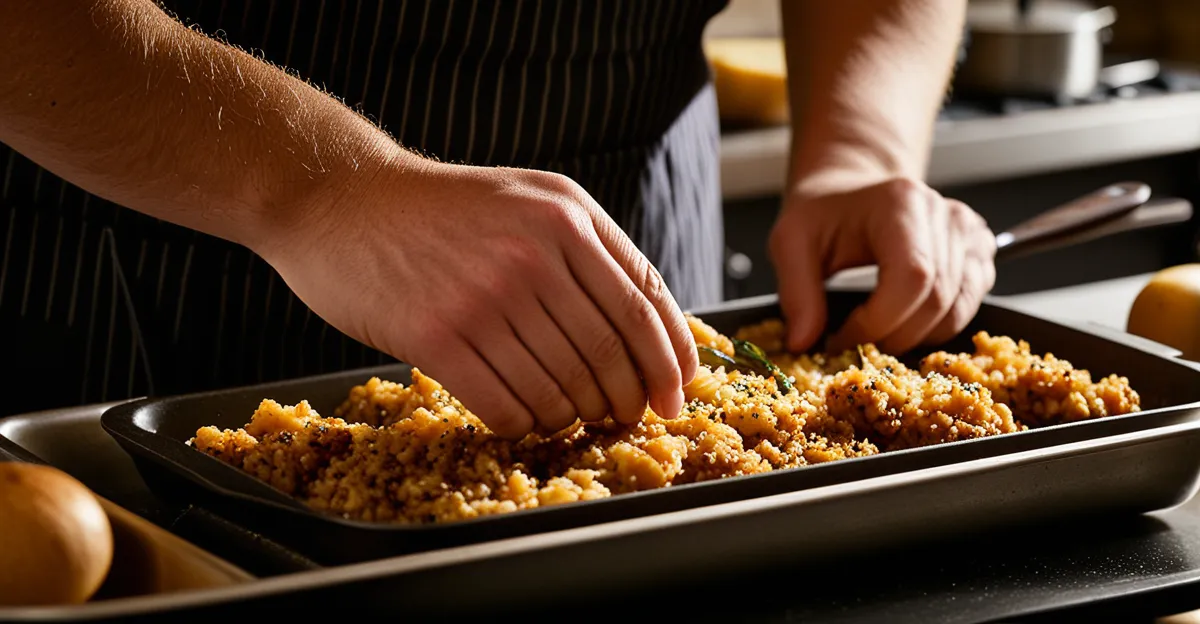Core Cooking Techniques in Traditional UK Cuisine
Understanding traditional UK cooking methods reveals much about British culture and history. The foundational classic British culinary techniques of roasting, baking, stewing, boiling, and frying each contribute unique characteristics to UK food. Mastering these UK food preparation basics allows appreciation of the diverse range of flavors and textures found in traditional British dishes.
Roasting has long been revered in UK cuisine, particularly for its role in cooking meats like beef, lamb, and poultry. This method, often performed in an oven or over an open fire, slowly cooks food to tender perfection while developing rich, caramelized flavors. The cultural significance of roasting is evident in the iconic British roast dinner, a staple Sunday meal featuring roasted meat accompanied by vegetables and Yorkshire pudding.
Also to discover : How do you bake a traditional Bakewell tart from scratch?
Baking is another crucial technique, shaping beloved UK baked goods such as pies, pasties, and scones. British baking techniques emphasize the art of preparing shortcrust and puff pastry doughs, which provide a flaky, buttery texture integral to these dishes. Regional recipes heavily influence baking traditions, highlighting local ingredients and customs.
Stewing and boiling methods have historically offered economical, hearty meals ideal for preserving flavor and tenderizing tougher cuts of meat. Traditional stewing involves slow cooking meats and vegetables in liquid, creating comforting dishes with deep, developed flavors. Boiling is essential for classics like corned beef and boiled puddings, illustrating how these methods became staples due to their practicality and nourishing qualities in the UK’s culinary repertoire.
Additional reading : What Are the Most Iconic Dishes in British Cuisine?
Finally, traditional frying methods evolve from shallow frying to deeper techniques, playing a vital role in recipes such as the beloved fish and chips and bubble and squeak. British frying techniques continue to adapt in response to changing tastes and health considerations, reflecting a dynamic culinary tradition.
Together, these core cooking techniques form the backbone of traditional UK cuisine, each bringing its own history, flavor, and cultural importance to the table.
Stewing and Boiling for Hearty Meals
Traditional UK cooking methods heavily rely on stewing and boiling to create nourishing, flavourful dishes that have endured through centuries. Stewing involves slow-cooking meat and vegetables in a liquid, allowing tough cuts to become tender while intensifying the depth of flavours. It is a prime example of classic British culinary techniques that emphasize both economy and taste, making the most of every ingredient.
Boiling, another key technique, is essential in preparing several historical and modern dishes. Signature boiled foods like corned beef and boiled puddings showcase the simplicity and effectiveness of this method in extracting and concentrating flavours. The process is also vital for specialty recipes such as pease pudding, which relies on thorough boiling to achieve its creamy consistency.
These methods gained prominence due to their practical benefits: they preserved food before refrigeration and made use of less tender cuts by transforming them into satisfying meals. Today, stewing and boiling continue as staples of UK food preparation basics, providing comfort and tradition in dishes enjoyed across the nation.
Traditional Frying Methods in UK Cuisine
Traditional UK cooking methods include a rich heritage of British frying techniques, ranging from shallow frying to deeper methods. Shallow frying typically involves cooking food in a small amount of fat, preserving moisture and texture, while deep frying fully immerses ingredients in hot oil, yielding a crispy exterior. These techniques are essential UK food preparation basics that have evolved yet remain central to the flavor profiles of classic dishes.
Among iconic fried foods, fish and chips stands out as a defining example of British culinary tradition. The fish is lightly battered and deep-fried until golden, providing a satisfying contrast of crunchy coating to tender fish inside. Another traditional dish is bubble and squeak, which usually employs shallow frying to crisp leftover vegetables and potatoes, showcasing economical and flavorful use of ingredients—a hallmark of classic British culinary techniques.
Over time, British frying practices have adapted to health trends, with more emphasis now on controlling oil types and cooking temperatures to reduce fat absorption without compromising taste. Nonetheless, frying continues to play a vital role in maintaining the authenticity and enjoyment of many beloved UK recipes.
Iconic Dishes Showcasing Essential Techniques
Traditional UK cooking methods come alive in a variety of traditional British dishes that highlight the richness of classic British culinary techniques. Each dish embodies specific UK food preparation basics, showcasing skills like roasting, baking, stewing, boiling, and frying that have been honed over centuries.
The classic Sunday roast is a prime example of roasting in UK cuisine, featuring roasted meats such as beef or lamb paired with Yorkshire pudding, roasted vegetables, and gravy. This dish epitomizes the cultural importance of the roasting technique in British food history, bringing families together around the table for a filling and flavorful meal.
Shepherd’s pie and cottage pie illustrate the use of stewing and boiling methods merged with baking. These dishes combine slow-cooked, seasoned meats cooked through stewing techniques with a topping of creamy mashed potatoes baked to golden perfection. This layering demonstrates mastery of multiple UK food preparation basics, resulting in hearty and comforting dishes that remain popular.
Fish and chips famously represent British frying techniques. The fish is coated in a batter and deep-fried to achieve a light, crispy texture while maintaining moisture inside. Served with fried potatoes, this dish showcases how traditional frying methods can create satisfying textures and tastes that have become UK food traditions.
Stews and hotpots highlight the enduring role of stewing and boiling in British cuisine. Slow-cooked meats and vegetables simmer gently for hours, developing rich flavors and tender textures. Hotpots often incorporate regional ingredients, further reflecting the diversity within UK food traditions.
Finally, regional pasties and pies reveal the significance of British baking techniques, especially shortcrust and puff pastry doughs. These portable pies contain savory fillings that benefit from precise baking to create flaky, buttery crusts essential to the dish’s identity.
Together, these iconic dishes embody the essence of traditional UK cooking methods, preserving culinary heritage while continuing to satisfy modern palates.
Baking Traditions in the UK
Baking is a fundamental pillar of traditional UK cooking methods, celebrated for its deep-rooted cultural significance and regional variety. Central to these British baking techniques are the preparation and mastery of shortcrust and puff pastry doughs, which form the base of many cherished baked goods. Shortcrust pastry offers a tender, crumbly texture ideal for savory pies and pasties, while puff pastry’s multiple flaky layers give a light, buttery finish prized in dishes like sausage rolls and fruit tarts.
Famous UK baked goods such as pies, pasties, and scones showcase the breadth of British baking tradition. Pies, often filled with meats or vegetables, rely heavily on precise dough handling and baking time to achieve the sought-after crisp crust with a moist interior. Pasties, originating from Cornwall, emphasize portability and have distinctive hand-crimped edges, reflecting regional baking ingenuity. Scones, a staple of afternoon tea, highlight the subtle balance of leavening and fat to create a soft yet slightly crumbly texture.
Regional recipes profoundly influence UK baking practices, with local ingredients and customs shaping variations. For instance, Scottish shortbread uses a crumbly, buttery dough distinct from English pie crusts, while Welsh bara brith integrates dried fruits into a spiced bread. These adaptations serve as living examples of the ongoing evolution within UK food preparation basics, illustrating how baking continues to be a cultural touchstone that binds communities and honours heritage.
By preserving time-honoured techniques and embracing regional diversity, baking remains a vibrant and essential component of classic British culinary techniques, inviting both tradition and innovation to the British table.









